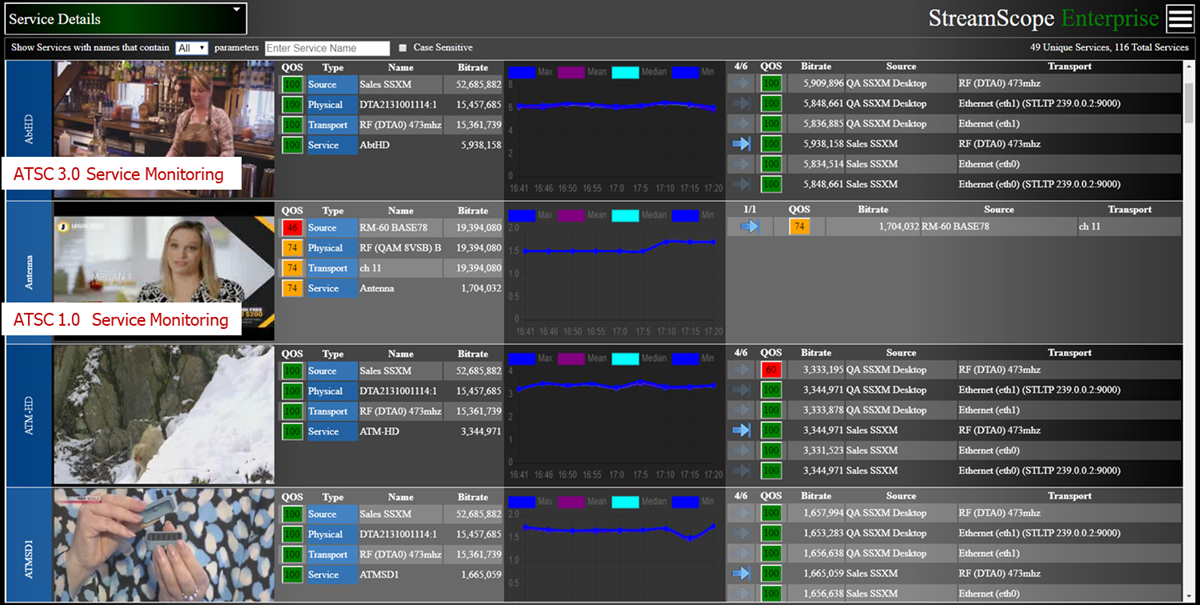A guide to centralized NextGen TV monitoring and analysis

Subscribe to NCS for the latest news, project case studies and product announcements in broadcast technology, creative design and engineering delivered to your inbox.
ATSC 3.0 deployments are progressing rapidly across the U.S., and the new era of digital television promises to dramatically improve the television experience for viewers. NextGen TV offers interactive program enhancements, innovative service guides, and many more benefits.
As broadcasters embrace the new broadcast television environment, delivering a high-quality television experience to viewers is critical. For station group owners, duopolies, and multiple stations in particular, having a centralized monitoring solution is essential for ensuring enterprisewide quality-of-service (QoS) assurance for ATSC 3.0 delivery.
NextGen TV Service Assurance Challenges
NextGen TV broadcast technology is complicated. ATSC 3.0 delivery combines new data-oriented services with traditional linear television programs and the addition of interactivity and broadcaster applications. NextGen TV standards are substantially different than ATSC 1.0, and there is a significant learning curve for broadcasters when it comes to integrating ATSC 3.0 solutions into the ecosystem.
Moreover, the ATSC 3.0 platform is not backwards compatible. Consequently, broadcasters will need to operate both ATSC 1.0 and ATSC 3.0 simultaneously for the foreseeable future.
The centralized nature of NextGen TV operations also adds complexity. Today, there is an increasing trend toward multiple stations sharing facilities as well as more centralized operations with smaller technical staffs to support them. Broadcasters are operating in an increasingly complex, multi-vendor environment that necessitates tools for quick problem identification and isolation across multiple air chain elements.
Key Advantages of Enterprise Analysis and Monitoring
Given the unique challenges of the NextGen TV environment, having enterprise-wide visibility into service assurance issues can optimize error resolution. With centralized ATSC 3.0 broadcast analysis and verification tools, stations can quickly detect, isolate, and resolve issues.
Furthermore, enterprise-based solutions make it easy for stations to share expertise and applications as needed.
Best Practices for NextGen Service Assurance
The ATSC 3.0 environment is infinitely more complex than ATSC 1.0. To make a smooth transition to NextGen TV, here are several best practices and capabilities that are a must for monitoring and analysis:
- Simultaneous ATSC 1.0 and ATSC 3.0 service assurance: Stations need quick and effective tools to evaluate the quality of both ATSC 1.0 and ATSC 3.0 transmissions. By leveraging solutions that offer support for both sets of standards, broadcasters obtain a holistic overview of their broadcast network, enabling optimized service assurance and more efficient troubleshooting — especially in enterprise settings.
- Powerful analysis: Analysis is absolutely critical in the ATSC 3.0 environment, in particular analyzing the variety of interchange formats and inputs. Analysis makes debugging of complex issues tractable and straightforward and should be available for system configuration validation on-demand as needed.
- Robust monitoring: A high-performance monitoring system will ensure that ATSC 1.0 and ASTC 3.0 operations comply with the defined standards, operational settings, and business decisions such as bandwidth allocations. Putting monitoring in place also guarantees that out-of-bounds conditions trigger notifications, enabling rapid response when warranted. Monitoring should include robust logging for postmortem analysis and audit trails and should be a continuous function of the system.
- User-friendly dashboards: Service quality assurance equipment needs to be efficient and simple to use. With centralized dashboards, broadcasters can see powerful visual representations of the operating state. From a single dashboard, broadcasters can view the status of ATSC 1.0 and ATSC 3.0 services in real time. Dashboards that can be customized will make the transition to NextGen TV even simpler. TV engineers and other key personnel can create dashboards for a single user or for a group of users to enable more efficient, enterprisewide QoS assurance.
In Summary
By deploying an enterprise platform for NextGen TV service delivery and monitoring, broadcasters can efficiently manage a variety of quality assurance elements, view overall system status, and launch problem-solving sessions for specific faults detected in ATSC 1.0 and ATSC 3.0 environments. Choosing a solution that supports ATSC 1.0 and ATSC 3.0 transmissions, with powerful analysis, robust monitoring, and user-friendly dashboards will assure exceptional quality television services and streamline operations across the broadcast enterprise as stations move forward with this monumental technology transformation.
Subscribe to NCS for the latest news, project case studies and product announcements in broadcast technology, creative design and engineering delivered to your inbox.




tags
Monitoring, NextGen TV ATSC 3.0, Ralph Bachofen, Triveni Digital
categories
Broadcast Engineering, Broadcast Industry News, Featured, Monitoring, Signal Processing, Thought Leadership, Voices